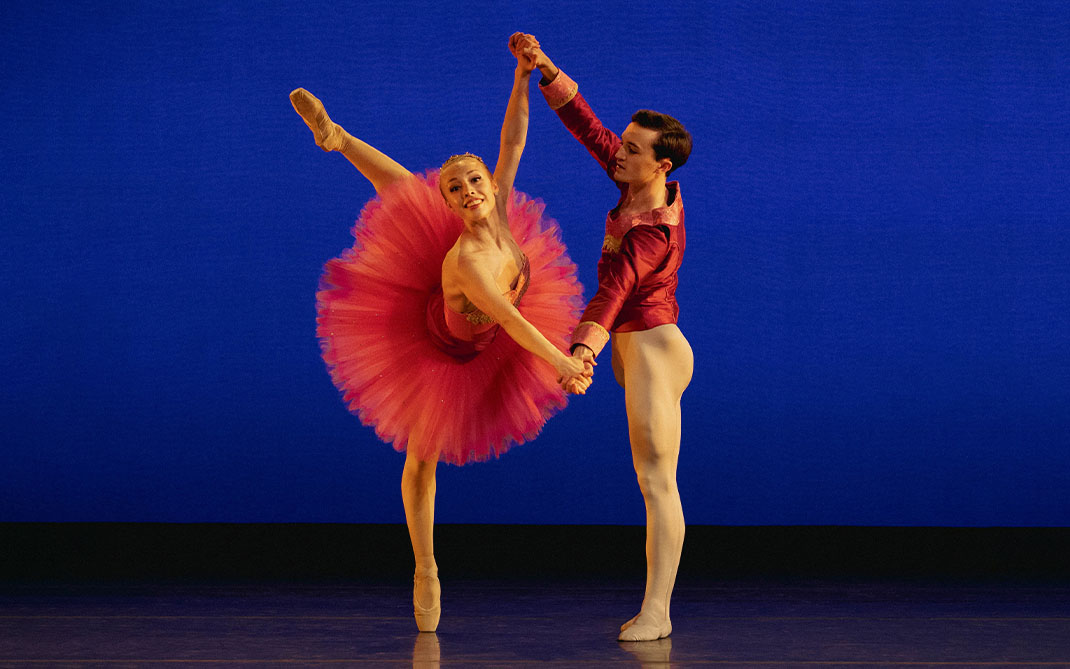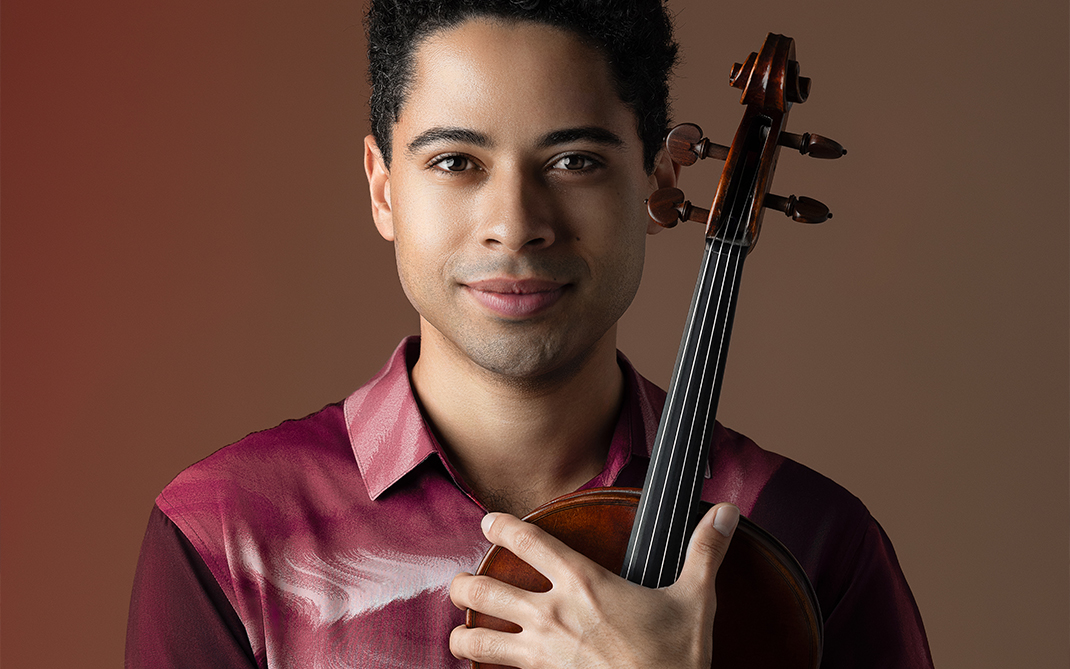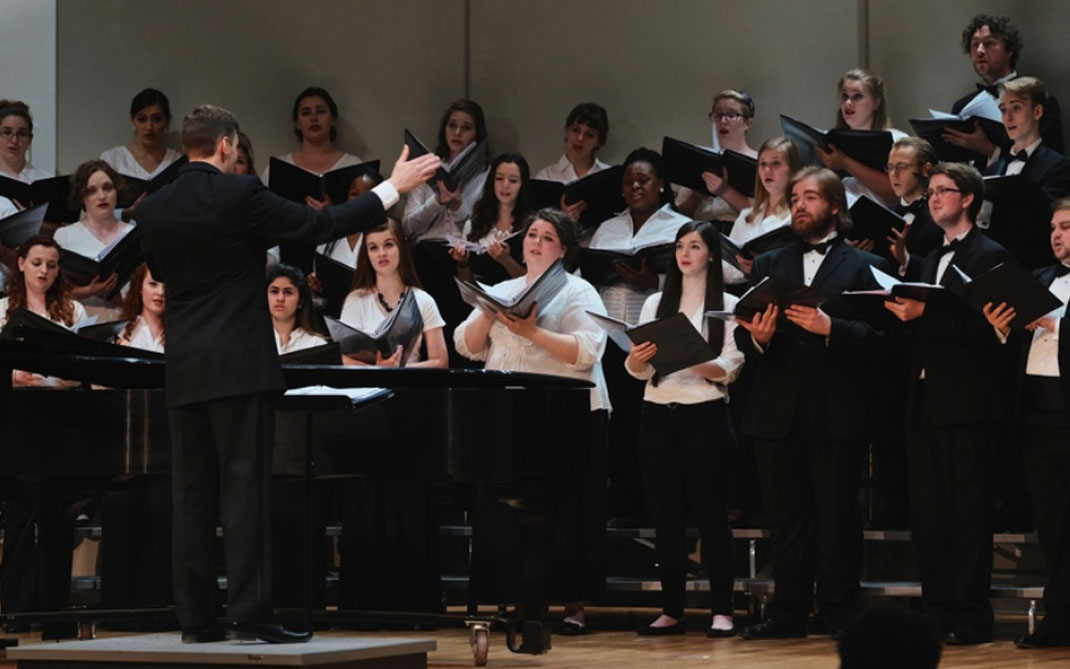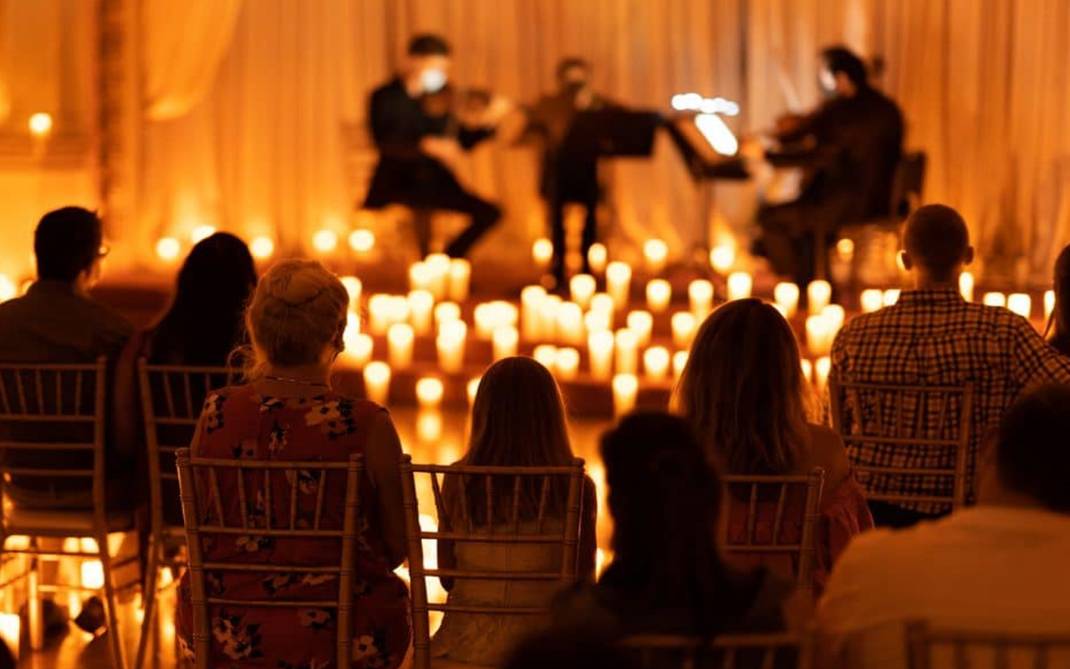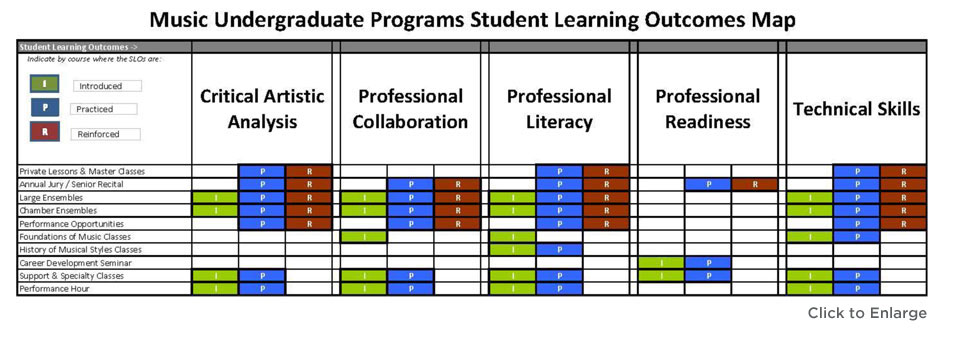Music BM Annual Report
Music BM Annual Report
The following Student Learning Objectives and assessment information is for Bachelor of Music undergraduate programs in the School of Music. Concentrations are offered in the areas of Brass, Composition, Guitar, Harp, Organ, Percussion, Piano, Strings, Voice and Woodwinds.
Program Mission
The School of Music’s stated mission and goals for the Bachelor of Music degree program focuses specifically on student learning:
“The School of Music of the University of North Carolina School of the Arts prepares students for professional careers. Our goal is twofold: to enable students to attain their highest musical aspirations and to meet the challenge of succeeding in a highly competitive profession. ... In its conservatory setting, UNCSA provides an artistic environment in which each student pursues personal musical development. But the School of Music is also a professional training ground in which the student actively and realistically prepares for the practical aspects of making a living as a musician.” (from the UNCSA 2015-2016 Undergraduate Bulletin, p. 189)
In addition, the School of Music’s stated program mission and goals clearly stem from the mission of UNCSA and align directly with the Mission Statement of UNCSA:
“The University of North Carolina School of the Arts provides gifted emerging artists with the experience, knowledge, and skills needed to excel in their disciplines and in their lives, and it serves and enriches the cultural and economic prosperity of the people of North Carolina and the nation. UNCSA is the state's unique professional school for the performing ... arts, training students ... for professional careers in the arts.” (from the UNCSA 2015-2016 Undergraduate Bulletin, p. 10)
Student Learning Objectives (SLOs)
SLO 1. Critical Artistic Analysis
- Perform or compose music at a level of artistry progressing toward professional employment
- Comprehend and evaluate multiple points of view about performance or composition techniques and musical expression
Assessment Plans and Activities
Direct Assessment
Performances and/or Final Projects
- Annual Juries/Graduation Recitals
First-of-Year Hearing (for certain concentrations), Fall Jury, and Spring Jury or Graduation Hearing and Recital - Public Large Ensemble Concerts
- Public Chamber Ensemble Concerts
One-on-One Instruction/Small Group Work
- Weekly private lessons
- Weekly master classes
Indirect Assessment
- Data from the 2016 School of Music Undergraduate Questionnaire
- Acceptance to graduate programs/Professional work obtained
SLO 2. Professional Collaboration
- Learn to function as a contributor to a work team such as a performing ensemble
Assessment Plans and Activities
Direct Assessment
Performances and/or Final Projects
- Annual Juries/Graduation Recitals
First-of-Year Hearing (for certain concentrations), Fall Jury, and Spring Jury or Graduation Hearing and Recital - Public Large Ensemble Concerts
- Public Chamber Ensemble Concerts
Indirect Assessment
- Data from the 2016 School of Music Undergraduate Questionnaire
- Acceptance to graduate programs/Professional work obtained
SLO 3. Professional Literacy
- Gain foundational level of familiarity with music literature, especially as it pertains to principal area of study
- Understand and interpret music in a variety of styles, genres, mediums and historical eras
Assessment Plans and Activities
Direct Assessment
Performances and/or Final Projects
- Annual Juries/Graduation Recitals
First-of-Year Hearing (for certain concentrations), Fall Jury, and Spring Jury or Graduation Hearing and Recital - Public Large Ensemble Concerts
- Public Chamber Ensemble Concerts
One-on-One Instruction/Small Group Work
- Weekly private lessons
- Weekly master classes
Indirect Assessment
- Data from the 2016 School of Music Undergraduate Questionnaire
- Acceptance to graduate programs/Professional work obtained
SLO 4. Professional Readiness
- Achieve awareness of practical information and realities of careers in music
- Demonstrate the ability to prepare, audition and/or interview for a graduate program of study
- Demonstrate knowledge of the grant writing process and the importance of developing entrepreneurial skills
- Demonstrate knowledge of arts-in-education and other community outreach venues
- Develop basic skills for using music technology
- Demonstrate basic writing skills as they apply to career development
Assessment Plans and Activities
Direct Assessment
- Annual Juries/Graduation Recitals
First-of-Year Hearing (for certain concentrations), Fall Jury, and Spring Jury or Graduation Hearing and Recital - Projects and other work products accomplished in Career Development Seminar
Indirect Assessment
- Data from the 2016 School of Music Undergraduate Questionnaire
- Acceptance to graduate programs/Professional work obtained
SLO 5. Technical Skills
- Perform or compose music at a level of technique progressing toward professional employment
Assessment Plans and Activities
Direct Assessment
Performances and/or Final Projects
- Annual Juries/Graduation Recitals
First-of-Year Hearing (for certain concentrations), Fall Jury, and Spring Jury or Graduation Hearing and Recital - Public Large Ensemble Concerts
- Public Chamber Ensemble Concerts
One-on-One Instruction/Small Group Work
- Weekly private lessons
- Weekly master classes
Indirect Assessment
- Data from the 2016 School of Music Undergraduate Questionnaire
- Acceptance to graduate programs/Professional work obtained
Evidence of Student Learning
The following Music Undergraduate Programs Student Learning Outcomes Map documents the connections between each of the five Music SLOs and courses and/or activities within the Music curricula.
The direct assessment data is qualitative and exists in a variety of types, including formats such as written jury and recital hearing comments, documented and recorded performances (some reviewed by outside critics), and artifacts from student projects and presentations. This qualitative data is valid and valuable within a conservatory environment. Nonetheless, the School of Music will be seeking ways to supplement this qualitative data with appropriate quantitative data, further enhancing our ability to assess program effectiveness and to track longitudinal trends.
The indirect assessment data is quantitative and primarily derives from the annual School of Music Undergraduate Questionnaire administered toward the end of each academic year. As part of this questionnaire, using a 5-point scale (1=very poor/needs significant improvement, 5=very good/needs no improvement), students are asked to rate how well they feel the undergraduate curriculum is helping/has helped them grow and achieve success in each of the five Music SLOs. The following table presents longitudinal data from the past three years:
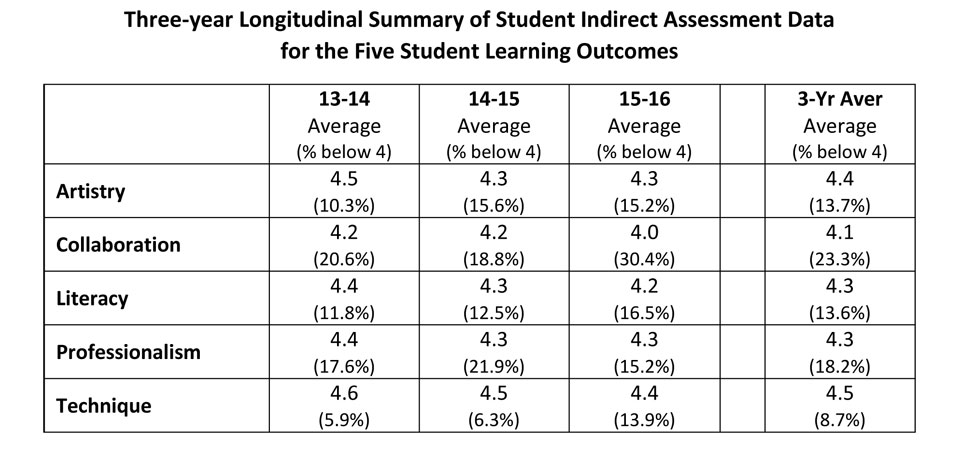
In addition, through the questionnaire students are also asked to rate explicit components
of the undergraduate curriculum. These curricular components are the same ones documented
in the SLO map presented above. Even though the students assess courses and activities,
not the actual SLOs, because of the background mapping with the SLOs the data provide
a valuable, alternate framework and lens through which to view the program as a whole
and to assess its overall health, including the status of the five SLOs. For example,
if students were to express concern about the effectiveness of lessons, not only would
the School of Music move to understand and address the concern about course effectiveness,
but because three SLOs (Artistry, Literacy, Technique) are embedded in lesson work,
the School of Music would also know to investigate more thoroughly possible negative
impacts upon those three SLOs.
The table titled "Three Year Longitudinal Summary of Student Indirect Assessment for Curricular Components and their Mapped SLOs" presents longitudinal data for these curricular components from the past three years. For each component, the pertinent SLOs mapped to that component are indicated.
The remainder of this section is organized into three subsections:
- The five SLOs with the 2015-2016 direct and indirect data;
- The nine curricular components and the 2015-2016 indirect data; and
- A summary of narrative data provided by students through the 2016 Undergraduate Questionnaire.
Subsection 1: The Five SLOs
SLO 1. Critical Artistic Analysis
Direct Assessment(s)
- All students successfully completed required juries or graduation recitals.
- Numerous highly successful concerts were mounted throughout the year, encompassing a range of opportunities including orchestra, wind ensemble, jazz ensemble, opera, and chamber ensemble.
- The vast majority of students accomplished satisfactory work in their major area of study.
Indirect Assessment(s)
- Through the 2016 Undergraduate Questionnaire, students assessed a learning outcome of 4.3 out of 5.0.
[Average score = 4.3; 79 responses; 12 students (15.2%) rated below a score of 4; these 12 students represent brass, keyboard, strings, voice, and woodwind concentrations; these 12 students represent C1, C2, C3, and C4 class levels; these 12 students represent male and female genders; these 12 students represent Hispanic and White ethnicities; these 12 students represent North Carolina and out-of-state residents.]
SLO 2. Professional Collaboration
Direct Assessment(s)
- All students successfully completed required juries or graduation recitals.
- Of particular note are the numerous and highly successful concerts that were presented throughout the year. These concerts encompassed a range of opportunities including orchestra, wind ensemble, jazz ensemble, opera, and chamber ensemble. Among the many performances, notable standouts include Orff’s Carmina Burana in which the UNCSA Symphony Orchestra collaborated with the UNCSA Cantata Singers and the Winston-Salem Symphony Chorale, Bach’s Magnificat in which the UNCSA Cantata Singers collaborated with the Magnolia Baroque Players, the four-concert Chrysalis Chamber Music Festival, and a four-concert tour of North Carolina mounted by the UNCSA Symphony Orchestra. In addition, the School of Music collaborated with other UNCSA schools in two A.J. Fletcher Opera Institute productions (Rota’s The Italian Straw Hat and Brook’s reworking of Carmen), in CP Taylor’s musical Good, and in the annual UNCSA production of Tchaikovsky’s ballet The Nutcracker.
Indirect Assessment(s)
- Through the 2016 Undergraduate Questionnaire, students assessed a learning outcome of 4.0 out of 5.0.
[Average score = 4.0; 79 responses; 24 students (30.4%) rated below a score of 4; these 24 students represent composition, keyboard, percussion, strings, voice, and woodwind concentrations; these 24 students represent C1, C2, C3, and C4 class levels; these 24 students represent male and female genders; these 24 students represent Asian, Black, and White ethnicities; these 24 students represent North Carolina and out-of-state residents.]
SLO 3. Professional Literacy
Direct Assessment(s)
- All students successfully completed required juries or graduation recitals.
- The number of performances presented during the academic year, combined with the range of repertoire represented by those performances, attest positively to the level of professional literacy provided by the program.
- Numerous highly successful concerts were mounted throughout the year, encompassing a range of opportunities including orchestra, wind ensemble, jazz ensemble, opera, and chamber ensemble.
- The vast majority of students accomplished satisfactory work in their major area of study.
Indirect Assessment(s)
- Through the 2016 Undergraduate Questionnaire, students assessed a learning outcome of 4.2 out of 5.0.
[Average score = 4.2; 79 responses; 13 students (16.5%) rated below a score of 4; these 13 students represent composition, guitar, strings, voice, and woodwind concentrations; these 13 students represent C1, C2, C3, and C4 class levels; these 13 students represent male and female genders; these 13 students represent Black, Hispanic, and White ethnicities; these 13 students represent North Carolina and out-of-state residents.]
SLO 4. Professional Readiness
Direct Assessment(s)
- All students successfully completed required juries or graduation recitals.
- Separate from the actual course grade, students receive regular feedback from faculty of the Career Development Seminar regarding the creation of important professional documents, such as resumé, performance bio, “informance” presentations, and grant writing.
Indirect Assessment(s)
- Through the 2016 Undergraduate Questionnaire, students assessed a learning outcome of 4.3 out of 5.0.
[Average score = 4.3; 79 responses; 12 students (15.2%) rated below a score of 4; these 12 students represent brass, strings, voice, and woodwind concentrations; these 12 students represent C1, C2, C3, and C4 class levels; these 12 students represent male and female genders; these 12 students represent White ethnicities; these 12 students represent North Carolina and out-of-state residents.]
SLO 5. Technical Skills
Direct Assessment(s)
- All students successfully completed required juries or graduation recitals.
- Numerous highly successful concerts were mounted throughout the year involving repertoire that encompassed a range of technical skills and abilities.
- The vast majority of students accomplished satisfactory work in their major area of study.
Indirect Assessment(s)
- Through the 2016 Undergraduate Questionnaire, students assessed a learning outcome of 4.4 out of 5.0.
[Average score = 4.4; 79 responses; 11 students (13.9%) rated below a score of 4; these 11 students represent composition, guitar, keyboard, strings, voice, and woodwind concentrations; these 11 students represent C1, C2, C3, and C4 class levels; these 11 students represent male and female genders; these 11 students represent Asian, Black, and White ethnicities; these 11 students represent North Carolina and out-of-state residents.]
Interpretation
Interpretation: Based upon the available direct qualitative data and indirect quantitative data, all five SLOs appear to be stable and sufficiently strong.
Note: In the 2013-2014 School of Music Student Learning Outcomes Progress Report, the observation was made that after having been assessed by students as the weakest outcome for several years, Professional Readiness showed the largest gain (0.4) of any of the SLOs, registering at 4.4. This gain was in spite of increased concern among the students regarding the Career Development Seminar. In the 2014-2015 report, most of the gain from the previous year was maintained, the value being only slightly lower at 4.3. The current 2015-2016 report now appears to affirm the gains first noted in the 2013-2014 report.
Subsection 2: The Nine Curricular Components
1. Private Lessons & Master Classes
Mapped SLOs at level of Practiced and/or Reinforced: Artistry, Literacy, Technique
Indirect Assessment(s)
Lessons: Through the 2016 Undergraduate Questionnaire, students assessed a learning outcome of 4.8 out of 5.0.
Average score = 4.8; 78 responses; 2 students (2.6%) rated below a score of 4; these 2 students represent guitar and strings; these 2 students represent C2 and C3 class levels; these 2 students represent male and female genders; these 2 students represent White ethnicity; these 2 students represent North Carolina and out-of-state residents.
Master Classes: Through the 2016 Undergraduate Questionnaire, students assessed a learning outcome of 4.6 out of 5.0.
Average score = 4.6; 75 responses; 5 students (6.7%) rated below a score of 4; these 5 students represent guitar, keyboard, and voice; these 5 students represent C1, C3, and C4 class levels; these 5 students represent male and female genders; these 5 students represent White ethnicity; these 5 students represent North Carolina and out-of-state residents.
Overall Interpretation
Assessment indicates this component to be strong and stable.
2. Large Ensembles
Mapped SLOs at level of Practiced and/or Reinforced: Artistry, Collaboration, Literacy, Technique
Indirect Assessment(s)
Orchestra: Through the 2016 Undergraduate Questionnaire, students assessed a learning outcome of 4.3 out of 5.0.
Average score = 4.3; 32 responses; 3 students (9.4%) rated below a score of 4; these 3 students represent strings; these 3 students represent C1, C2, and C3 class levels; these 3 students represent male and female genders; these 3 students represent Hispanic and White ethnicities; these 3 students represent North Carolina and out-of-state residents.
Interpretation: Last year’s indirect quantitative assessment (2014-2015) generated a value of 4.4, a value that captured student assessment of the orchestral program at the end of the new Director of Orchestral Activities’ first year. At that point, it was the highest value recorded in orchestra since the implementation of the annual Undergraduate Questionnaire in the 2006-07 academic year. The current assessment (2015-2016) generates a value of 4.3 and affirms student perception of the strength of the orchestral program.
Wind Ensemble: Through the 2016 Undergraduate Questionnaire, students assessed a learning outcome of 4.0 out of 5.0.
Average score = 4.0; 23 responses; 6 students (26.1%) rated below a score of 4; these 6 students represent brass, percussion, and woodwinds; these 6 students represent C1, C3, and C4 class levels; these 6 students represent male and female genders; these 6 students represent Asian and White ethnicities; these 6 students represent North Carolina and out-of-state residents.
Interpretation: The indirect quantitative assessments from the past two years (2013-2014 and 2014-2015) both generated values of 3.6; the current assessment (2015-2016) generates a value of 4.0, indicating a significant and positive increase in the strength of Wind Ensemble.
Jazz Ensemble: Through the 2016 Undergraduate Questionnaire, students assessed a learning outcome of 4.2 out of 5.0.
Average score = 4.2; 12 responses; 2 students (16.7%) rated below a score of 4; these 2 students represent strings; these 2 students represent C1 and C2 class levels; these 2 students represent male gender; these 2 students represent White ethnicity; these 2 students represent out-of-state residents.
Cantata Singers: Through the 2016 Undergraduate Questionnaire, students assessed a learning outcome of 3.8 out of 5.0.
Average score = 3.8; 28 responses; 9 students (32.1%) rated below a score of 4; these 9 students represent voice; these 9 students represent C1, C2, and C4 class levels; these 9 students represent male and female genders; these 9 students represent Black and White ethnicities; these 9 students represent North Carolina and out-of-state residents.
Interpretation: Last year’s report related the departure of the long-time and much beloved Cantata Singers director, along with the historically-low student assessment value of 3.8 for the season led by the subsequent interim adjunct director. The current assessment (2015- 2016) replicates that value of 3.8. In addition, narrative comments document significantly increased student desire for reduced rehearsal time (meeting something less than five days per week), a component that might have direct relation not so much to the director but to more general student concerns about workload and schedule commitments.
Overall Interpretation
Assessment indicates this component to be mostly on track, with possible issues beginning
to emerge in Cantata Singers.
3. Chamber Music
Mapped SLOs at level of Practiced and/or Reinforced: Artistry, Collaboration, Literacy, Technique
Indirect Assessment(s)
Through the 2016 Undergraduate Questionnaire, students assessed a learning outcome of 4.8 out of 4.0.
Average score = 4.0; 34 responses; 11 students (32.4%) rated below a score of 4; these 11 students represent brass, guitar, keyboard, strings, and woodwinds; these 11 students represent C1, C2, C3, and C4 class levels; these 11 students represent male and female genders; these 11 students represent Asian and White ethnicities; these 11 students represent North Carolina and out-of-state residents.
Interpretation
Assessment indicates this component to be stable, yet also to evidence persistent
concern from string faculty regarding schedule issues. Direct faculty assessment during
the past two years (2013-2014 and 2014-2015) chronicle faculty concern about the string
chamber music schedule changes made in the 2013-2014 academic year, adjustments made
in response to necessary changes in the Wind Ensemble rehearsal schedule. Faculty
assessment from the current year (2015-2016) once again reinforced that concern.
4. Performance Opportunities
Mapped SLOs at level of Practiced and/or Reinforced: Artistry, Collaboration, Literacy, Technique
Indirect Assessment(s)
Types of Performance Opportunities: Through the 2016 Undergraduate Questionnaire, students assessed a learning outcome of 4.0 out of 5.0.
Average score = 4.0; 78 responses; 25 students (32.1%) rated below a score of 4; these 25 students represent brass, composition, guitar, keyboard, strings, voice, and woodwinds; these 25 students represent C1, C2, C3, and C4 class levels; these 25 students represent male and female genders; these 25 students represent Black, Hispanic, and White ethnicities; these 25 students represent North Carolina and out-of-state residents.
Number of Performance Opportunities: Through the 2016 Undergraduate Questionnaire, students assessed a learning outcome of 3.8 out of 5.0.
Average score = 3.8; 78 responses; 27 students (34.6%) rated below a score of 4; these 27 students represent brass, composition, guitar, keyboard, strings, voice, and woodwinds; these 27 students represent C1, C2, C3, and C4 class levels; these 27 students represent male and female genders; these 27 students represent Asian, Black, and White ethnicities; these 27 students represent North Carolina and out-of-state residents.
Overall Interpretation
Within the realm of performance opportunities, in terms of student assessment the
number of opportunities has historically lagged behind the types of opportunities.
The quantitative indirect data from the most recent 2016 School of Music Undergraduate
Questionnaire is no exception. Yet a significant number of students relate through
narrative response that the numbers and types of performance opportunities is a specific
strength of the undergraduate program. This suggests that there might be specific
subgroups of students who are either served especially well or who are distinctly
underserved.
5. Foundations of Music Classes
Mapped SLOs at level of Practiced and/or Reinforced: Technique
Indirect Assessment(s)
Theory: Through the 2016 Undergraduate Questionnaire, students assessed a learning outcome of 4.3 out of 5.0.
Average score = 4.3; 79 responses; 14 students (17.7%) rated below a score of 4; these 14 students represent brass, composition, keyboard, percussion, strings, and voice; these 14 students represent C1, C2, C3, and C4 class levels; these 14 students represent male and female genders; these 14 students represent Black, Hispanic, and White ethnicities; these 14 students represent North Carolina and out-of-state residents.
Aural Skills: Through the 2016 Undergraduate Questionnaire, students assessed a learning outcome of 4.4 out of 5.0.
Average score = 4.4; 78 responses; 12 students (15.4%) rated below a score of 4; these 12 students represent keyboard, percussion, strings, and voice; these 12 students represent C1 and C2 class levels; these 12 students represent male and female genders; these 12 students represent Asian, Hispanic, and White ethnicities; these 12 students represent North Carolina and out-of-state residents.
Keyboard Skills: Through the 2016 Undergraduate Questionnaire, students assessed a learning outcome of 4.4 out of 5.0.
Average score = 4.4; 77 responses; 12 students (15.6%) rated below a score of 4; these 12 students represent brass, composition, keyboard, strings, and voice; these 12 students represent C1 and C2 class levels; these 12 students represent male and female genders; these 12 students represent Hispanic and White ethnicities; these 12 students represent North Carolina and out-of-state residents.
Overall Interpretation
Assessment indicates this component to be strong and stable.
6. History of Musical Style Classes
Mapped SLOs at level of Practiced and/or Reinforced: Literacy
Indirect Assessment(s)
Through the 2016 Undergraduate Questionnaire, students assessed a learning outcome of 4.1 out of 5.0.
Average score = 4.1; 45 responses; 12 students (26.7%) rated below a score of 4; these 12 students represent composition, keyboard, strings, voice, and woodwinds; these 12 students represent C2, C3, and C4 class levels; these 12 students represent male and female genders; these 12 students represent Black and White ethnicities; these 12 students represent North Carolina and out-of-state residents.
Interpretations
Assessment indicates this component to stable and perhaps even strengthening. In last
year’s report, the following observations were made:
“Student assessment of the History of Musical Styles sequence, as reported through the annual questionnaire, have continued to rise. While not yet at an all-time high (a value of 4.4 was achieved in the 2008 Undergraduate Questionnaire and assessed the former two-year sequence), the current value of 4.1 represents a high mark for assessment of the one-year survey format adopted when UNCSA moved to a semester system.
“Nonetheless, partly in response to continued student concern about the amount of material covered as well as faculty concern about the level of direct relevance of some of the material, during extended and extensive curriculum review and revision sessions held during the 2014-2015 academic year the decision was reached to begin the one- year survey with the Baroque. Exploration of Antiquity, Medieval, and Renaissance music will be reserved for an optional elective to be taken by students following the completion of the basic survey.”
The year just completed implemented the adjusted coverage of style periods described above, and the quantitative indirect assessment for 2015-2016 generated a second year in a row of student assessment at a level of 4.1 It is also worth noting that the usual professor of this class was on sabbatical leave throughout the entire year.
7. Career Development Seminar
Mapped SLOs at level of Practiced and/or Reinforced: Professionalism
Indirect Assessment(s)
Through the 2016 Undergraduate Questionnaire, students assessed a learning outcome of 2.4 out of 5.0.
Average score = 2.4; 28 responses; 25 students (89.3%) rated below a score of 4; these 25 students represent brass, composition, guitar, keyboard, strings, voice, and woodwinds; these 25 students represent C3 and C4 class levels; these 25 students represent male and female genders; these 25 students represent Asian, Black, Hispanic, and White ethnicities; these 25 students represent North Carolina and out-of-state residents.
Interpretations
Robust faculty discussion through an extended and extensive curriculum review and
revision process conducted during the 2014-2015 academic year resulted in the decision
to phase out the current Career Development Seminar and to replace it with a series
of three, or perhaps four, smaller courses strategically placed throughout the four
years of the curriculum. Not only are specifics of these changes still being refined,
but it will be at least one more year before they can work their way through to this
third-year class. With this in view, this past year Music administration made efforts
to reenergize the course by assigning a team of three faculty to teach it. Despite
these efforts, the current 2015-2016 indirect student assessment of 2.4 represents
a low point for Career Development Seminar since the inception of the School of Music
Undergraduate Questionnaire in the 2006-2007 academic year.
8. Support & Specialty Classes
Mapped SLOs at level of Practiced and/or Reinforced: Artistry, Collaboration, Literacy, Professionalism, Technique
Indirect Assessment(s)
Through the 2016 Undergraduate Questionnaire, students assessed a learning outcome of 4.7 out of 5.0.
Average score = 4.7; 43 responses; 0 students (0.0%) rated below a score of 4.
Interpretations
Assessment indicates this component to be strong and stable.
9. Performance Hour
Mapped SLOs at level of Practiced and/or Reinforced: Artistry, Collaboration, Literacy, Technique
Indirect Assessment(s)
Through the 2016 Undergraduate Questionnaire, students assessed a learning outcome of 4.0 out of 5.0.
Average score = 4.0; 79 responses; 17 students (21.5%) rated below a score of 4; these 17 students represent guitar, strings, voice, and woodwinds; these 17 students represent C1, C2, C3, and C4 class levels; these 17 students represent male and female genders; these 17 students represent Black and White ethnicities; these 17 students represent North Carolina and out-of-state residents.
Interpretations
Assessment indicates this component to be strong and stable.
Subsection 3: Student Narrative Comments from 2016 Questionnaire
Students were invited to respond to the questions, “What aspect(s) of your experience at UNCSA have you found particularly successful?” and “What suggestion(s) would you make for improving the undergraduate music curriculum?” Finally, they were invited to provide any additional comments they wished.
Successful Experiences – Top 3
In response to the question about particularly successful experiences, the top three were:
- The quality of the faculty who teach individual private lessons and master classes and the value of those lessons and master classes (31 students named this as a specific strength);
- The quality of the School of Music faculty in general (16 students highlighted this aspect of the School of Music, and an additional 10 faculty members were named specifically); and
- The performance and collaboration opportunities available (17 students made specific mention).
Successful Experiences – Second Tier
In addition, three other answers formed a second tier of successful experiences:
- The quality of the Foundations of Music program (9 students identified one or more of the component classes (theory, aural skills, and keyboard skills);
- The opportunities for improvement and growth as a musician (8 students highlighted this aspect); and
- The arts environment in general and the positive interaction with peers (8 students named these aspects).
Suggestions for Improvement
In response to the question requesting suggestions for improvement, there were two most frequently identified areas, with the first falling into two sub-groups:
- Workload as a general topic remained in the fore for a second year in a row, with
two sub-issues clearly delineated:
- 12 students felt there was too big a workload in general; and
- 7 students, a majority of whom are voice concentration students, identified various curricular or course imbalances and overloads.
- Career Development Seminar continued to generate responses (8 students).
Use of Student Learning Evidence
The five School of Music Student Learning Outcomes appear to be stable and sufficiently strong. Nonetheless, analysis of certain curricular components results in the following five actions, each of which, either directly or indirectly, will impact one or more of the five SLOs.
New Schedule
Action #1: Creation, Implementation, and Monitoring of New Schedule
In response to continued issues spanning several years, in the Spring of 2013 the School of Music administration, in consultation with the faculty whose students participate in Wind Ensemble, identified a new director for the group. That adjunct faculty member began in the Fall of 2013. Given that faculty member’s existing duties at another institution, the Wind Ensemble rehearsal schedule needed to be adjusted, which in turn prompted a cascade of changes in the overall large ensemble, chamber ensemble, and master class schedules. These significant changes were made in consultation with the School of Music faculty through extensive discussion in the Dean’s Advisory Committee.
During the 2015-2016 academic year, concerns over these significant schedule changes combined with both School of Music internal and UNCSA campus-wide concerns regarding larger issues, such as overall student schedules and workloads. In terms of crafting solutions to some of these concerns, the inflexibility of the adjunct director’s schedule became untenable and the decision was made by Music’s interim dean to engage a different adjunct director for the coming year, thus enabling the implementation of a new schedule of large ensemble, chamber ensemble, and master class times. Throughout the latter part of Spring Semester, consensus regarding this new schedule was reached.
Cantata Singers Monitoring
Action #2: Cantata Singers Monitoring
Two aspects of Cantata Singers will be monitored by voice faculty and Music administration to ensure continued high-quality learning and development within the group: the work and effectiveness of the adjunct Cantata Singers director; and the implementation of the new large ensemble schedule, which contains a reduction from five to four rehearsals per week for Cantata Singers.
Comprehensive Analysis of Performance Opportunities
Action #3: Comprehensive Analysis of Types and Numbers of Performance Opportunities
In terms of the types and numbers of performance opportunities available to students, the data suggest there might be subgroups of students who are either served especially well or who are distinctly underserved. To attempt to investigate this possibility and to gauge how well in general students are served, the Associate Dean of the School of Music will lead an effort to develop and analyze additional and significant data related to this issue.
Continued Curriculum Revision
Action #4: Continued Undergraduate Curriculum Revision / Reshaping of Career Development Seminar
In the 2014-2015 academic year, intentional efforts were undertaken to review and revise the undergraduate Music curriculum. Before the process could conclude, the then-current dean moved to another institution and the review has since been in hiatus. With the arrival of a new dean this fall, the process will now restart.
Among goals previously articulated is the rethinking and reshaping of the Career Development Seminar, a curricular component closely connected with the SLO Professional Readiness and a course that has been struggling for several years. As an interim measure until the review can be completed, during this past year Music administration made efforts to reenergize the existing course by assigning a team of three faculty to teach it. While significant problems persisted, students nonetheless responded extremely positively to one of the three faculty on the team. Plans for the coming year include retaining that faculty member on the team, pairing them as the lead teacher with a new faculty member, as well as exploring and experimenting with ways in which the necessary content can be delivered through formats more engaging to the students.
Modified Academic Program Evaluation Plan
Action #5: Modified Academic Program Evaluation Plan
In an effort to increase and improve the quantity and quality of assessment data, the Associate Dean of the School of Music will lead faculty in the development and implementation of an expanded Academic Program Evaluation Plan. This plan is anticipated to contain the following enhancements:
- Faculty direct assessment: a mechanism will be created through which qualitative assessments can be translated into quantitative measures; and
- Student indirect assessment: a small-group, exit-interview process will be created through which students graduating from the undergraduate program can provide both quantitative ;and qualitative feedback. (NOTE: This will be in addition to continuing to administer the annual Undergraduate Student Questionnaire.)

